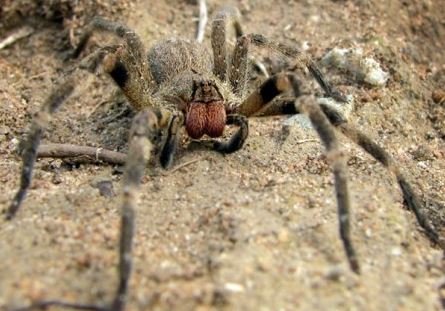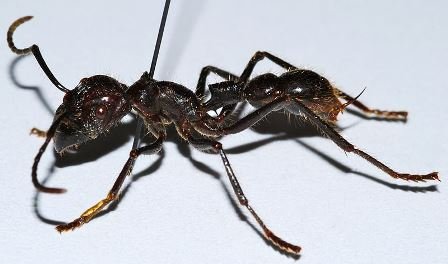Meet The ‘Baddest’ and Most Poisonous Animals Around Us - Pt 1
Hello!
Have you encountered a dangerous animal before? What kind of danger did the animal pose or does that specie of animal pose?
There are levels of dangers presented by animals found around us or within our immediate and neighbouring environments.
In reality however, most animals are dangerous, but some animals are more dangerous than others. (Yes, I know…..It isn’t exactly synonymous with the George Orwell’s famous animal-farm quote.)
But in truth, you do not want to flex abilities or intelligence with certain animals found on this our amazing planet).
On a scale of dangerous animals, some animal’s dangerous levels even surpass the danger scale itself.
You think you know dangerous animals? Well, let us check some of them out in the first part of this post series.
1.) The Phoneutria (Brazilian Wandering Spider)
When you consider dangerous nature of some spiders (air-breathing arthropods) in the world, then you would be surprised at how dangerous the Brazilian Wandering Spider is. This specie ranks as the world’s most dangerous spider.
If you think the synthetic spider that bit Peter Parker in the famous Spiderman comic was dangerous or perhaps you felt that spider was the real deal. Well, you need to guess again.
The Brazilian Wandering Spider holds the Guiness World Record for being the most venomous arachnid (Talk about a record breaking spider).
This spider is bad on so many levels. First of all, the name Phoneutria is its scientific name which is Greek in origin and means ‘murderess’. ref-1
If you get bitten, you can experience symptoms like;
- paralysis
- heart problems
- convulsions
- hypothermia
- asphyxiation
And you would never have thought about this one
- For men, you would suffer a painful erection that would not just go away. (Talk about an excruciating boner – lasting for up to four hours)
And guess what….between the venom released by the male and the female spider? The female releases a higher quantity of venom.
Behaviour of the Phoneutria (Brazilian Wandering Spider)
They usually don’t maintain a web or reside in a lair. At night, they wander the jungle floor. During the day, they hide under rocks, fallen logs, in banana plants and in termite mounds. (Think again, next time you visit the Amazon region and you feel like going loco on bananas. Three species could be waiting to embrace you). They mate from April to June, during the dry season.
(Guess which arthropods are having sexcapades this month?)
(You guessed right – The Brazilian Wandering Spiders)
Where can these badass spiders be found?
They are mostly found in the forest throughout Amazon region and South America comprising of Brazil, Costa Rica, Argentina, Columbia, Venezuela, Guianas, Ecuador, Peru, Bolivia, Paraguay, Panama. Recently, they have been introduced in Chile and Uruguay.
Their wandering abilities make them very dangerous too; as they can search for cover and hide in houses, clothes, boxes, boots, cars, and dark places, where they can easily unleash their venom when disturbed. ref-2, ref-3
This is another dangerous animal in so many ways. The ‘Golden Poison Frog’ as it is also known, does not even have to attack for it to do damage or kill. It has a skin coated with a very potent poison (an alkaloid toxin – Batrachotoxins). The poison once transmitted, screws up a victim’s system by The weird aspect is that, the alkaloid batrachotoxins can be housed in the frog for several years, and the toxins do not deteriorate easily, even when they have been transferred onto another surface. A major point to note however, is that the Golden Poison frog is not venomous (venomous animals deliver toxins through special body features such as spines, proboscis, fangs, etc.). It is just poisonous (poisonous animals rely on transference or physical contact of the toxin, mostly by, but not limited to, ingestion), and they use their poison only on accounts of self-defense, and not for intentional killing. The average Golden Dart Frog is estimated to host about one milligram of poison which is potent enough to obliterate roughly 10,000 mice. The same dose is strong enough to kill between 10 to 20 humans, or about two African bull elephants. (Such strength of a poison) This specie of frog is found mostly along the Pacific coasts of Columbia. ref-4, ref-5 This genus of octopus is seen as one of the most venomous marine lifeform. It is usually found in coral reefs around the Pacific and Indian oceans. They are relatively small in size (12cm to 20cm or 5 to 8 inches) - just about the size of a golf ball, but its poison is potent enough to send 26 healthy people to “great beyond” in just a few minutes, when irritated. The smallish murderer has a bite that is so painless that many victims do not even realize that they have been attacked by the tiny killer, until; Death from the bite of this octopus would largely be as a result of paralysis from the venom and respiratory arrest leading to suffocation from an inability to breathe. They mostly hide in crevices and exhibit high camouflaging abilities with the aid of their light-reflecting cells. They can easily and quickly change shape; an ability that enables them to fit into or pass through tight and smaller crevices than themselves. The octopus is capable of quickly changing its colour by becoming bright yellow and using each of its 50-60 rings to flash an iridescent blue colour in 1/3 of a second as a form of warning display. They further safeguard their lair by piling rocks at its entrance, thereby protecting themselves from larger predators. So, regardless of their size and docile nature, they are an exact example of the phrase “small but mighty”, because they also contain the very potent “tetrodotoxin” which is a powerful neurotoxin. ref-6, ref-7 According to the famous Dr. Justin Schmidt sting pain index list, the bullet ant holds a sting level index rating of “4+” (4 plus), above the highest rating on the Schmidt sting pain index. The pain of the bullet ant is rated above the Tarantula Hawk Wasp which possesses a very painful sting at a rating of “4” (the highest index on the Schmidt sting index). Victims of the insect sting describe the sting as synonymous to the feeling of getting shot (ergo, its name). The bite is also described as a feeling of a tsunami rising and falling all over the body. ref-8 They mostly inhabit the South American regions, especially the rainforest regions of Nicaragua, the eastern regions of Honduras and the Southern parts of Paraguay. The bullet ant serves as a ritual and initiation rite for the Sateré-Mawé Amazonian tribe of Brazil; in which a boy must stick his hands into a glove filled with a swarm of angry jungle ants for a specified duration of time, to prove himself a warrior. The Mawé people see the ability of a boy to withstand the pains of the sting of the bullet ant, as a true test of becoming a warrior. This ritual must be passed about 20 times over a period of months or years, before the boy is considered a warrior by the tribe. When stung by these angry trapped ants in the gloves, the hands of the boy are paralyzed due to the venom of the ant and he would feel uncontrollable pains for days. Only a charcoal coating on the hands is the protection involved in the ritual, and it aims to confuse the ants and to try to inhibit their stinging. ref-9, ref-10 You may see these arachnid, marine animals, and insects, and they may seem colourful, beautiful and photo-worthy; but be aware that despite how tiny, docile and seemingly harmless they may appear, they pack stings, bites and venomous toxins within them capable of killing and maiming humans. These species of animals have claimed lives as far as scientific studies have gone on to show us. I'd bring some more dangerous animals which we hardly know much about, to the spotlight, in the second part of this post. Thanks for reading.
2.) Golden Dart Frog
It is poisonous but not venomous
Its Poison
Where it is mostly found?
3.) The Blue Ring Octopus
Do you know the scariest part?
Behaviour of the Blue ring octopus
4.) Paraponera Cavata (The Bullet Ant)
Where can are these ant species endemic?
It inhabits humid lowland rainforests from Nicaragua and the extreme east of Honduras and south to Paraguay.Significance of the ant among the Mawé people of Brazil
First, the tribe’s medicine man numbs the ants by drugging them or sedating them in a local solution. This makes the ants unconscious for a while – long enough for the ants to be picked one by one and woven inside the gloves made by leaves, with the ant’s stingers facing inwards where the hands go into. After this is painstakingly done and the ants are awake, the boy wears the glove and dances while enduring the stings for not less than 5 to 10 minutes, in order to be considered a warrior.
Reference

@rickie




I must say this are some scary creatures, I doubt if I have ever encountered any of this creatures maybe because of the region is stay in but would sure watch out for them anytime I go to those region. Thanks for sharing.
Awesome post
Yea, scary is the term @promize123. You are lucky, they aren't around your vicinity though. Thanks for reading.
Hello! I find your post valuable for the wafrica community! Thanks for the great post! @wafrica is now following you! ALWAYs follow @wafrica and use the wafrica tag!
So much "power" for such creatures. It's not like they're defending nature or something. You should check out the Australian box Jellyfish, it's a killer. I'd really not want to meet any of these creatures.
Lolz......Nah! They are far from the "defenders of the galaxy" @nigtroy. I sure wouldn't like to face any of them either. Thanks for reading, buddy. I'd sure check out the Australian box jellyfish you mentioned.
The blue ring octopus be looking like these monsters featured in 'stranger things' by Netflix
Lolz.....I know right? Thanks for reading @harrywill
If the Wandering Spider bites me, will I turn to Spider-Man? :)
Lolz....... @samminator, you'd turn to something else entirely, but definitely not Spider-man. Thanks for reading, buddy.
These creatures are small but dangerous, I have been underestimating spiders for a long time. I never knew some are poisonous. Thanks for the information.